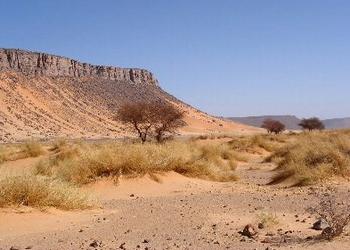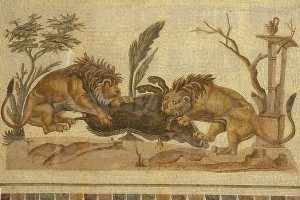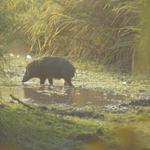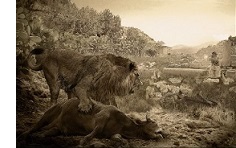
A view of the Sahara desert in Algeria – the last Algerian lions survived on the fringes of the Sahara into the 1940s with others surviving in northern coastal forests into the 1950s. (Photo by Florence Devouard)
The Bubal hartebeest is extinct, the dama gazelle and addax survive in only 1% of their former range, and various other hoofed animals from the region are extremely threatened: the Nubian Ibex clings on in parts of Algeria whilst the Barbary sheep fares a little better.
Of the major predators, the Barbary Lion has certainly been extinct in the wild for 50-60 years (assuming some of its ancestors still survive in a handful of zoos). The African wild dog no longer inhabits the Sahara desert (and was only present in southern fringes. The Saharan cheetah only inhabits 10 per cent of its former range, surviving largely unnoticed in southern Algeria. Similarly a small leopard population is known to survive in the southern Algerian Sahara, but is lost from 97 percent its historic range.
However there are opportunities for recovery: the scimitar horned oryx is extinct in the wild, but controlled releases in fenced reserves in Tunisia and Chad are looking to re-establish the wild population. Similarly the Addax has been reintroduced in fenced reserves in Morocco and Tunisia. The leopard was thought extinct in the late 1990s, but a small population appears to survive in the Atlas Mountains. Do these examples of experimental reintroductions and relic populations offer hope for wider recovery of North African and Saharan ecosystems?
Reading:
Anon (2013) Sahara Desert’s large mammals Slipping Into Extinction. Environmental News Service. December 5, 2013 http://ens-newswire.com/2013/12/05/sahara-deserts-large-mammals-slipping-into-extinction/
Busby et al (2009) Genetic analysis of scat reveals leopard (Panthera pardus) and cheetah (Acinonyx jubatus) in Algeria. Oryx, 43(3), 412–415
Wildlife Conservation Society. “Critically Endangered Cheetahs In Algeria Snapped With Camera Trap.” ScienceDaily. ScienceDaily, 27 February 2009. <www.sciencedaily.com/releases/2009/02/090227082603.htm>.



